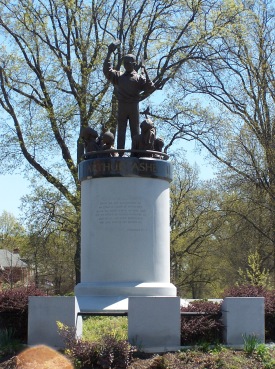
As the City of Richmond works its way to taking down all of the Confederate monuments and symbols within its limits, the Robert E. Lee Monument, which is owned by the Commonwealth of Virginia, still stands. For now.
The General A. P. Hill Monument, property of the city, at the traffic circle in the intersection of Laburnum Avenue and Hermitage Road, is another that remains on display. Hill is buried beneath the statue, so once the city determines how to properly unearth his remains and where they will go, he and the monument will be removed from the site. (Interesting thing about Hill though, since his death, it doesn’t seem like he’s gotten a peaceful rest. He was first buried in Chesterfield County in 1865, then moved to Hollywood Cemetery in 1867, to finally be interred beneath the monument made in his honor and located in what’s now one of the city’s most noisiest and busiest intersections. He’s been there since 1892, when the statue was unveiled.)

In 1890, the Lee Monument was the first monument set in Richmond – with a parade(!) – to honor those who fought to maintain slavery and its representation of the economic base of the South, built upon and bred by the backs of black men, women, and children for free and by force, and give tribute to those who lost that fight, that battle, that entire war. With the removal of such monuments in the state and around the nation by their respective governing bodies, local and otherwise, Governor Ralph Northam of Virginia had declared this monument to also be taken down. However, the descendants of the Allen family, who’d given the land to the Commonwealth to house the monument, have filed a lawsuit against the state, arguing that the state is breaking its agreement with the family. According to state records, when the plot at the intersection now known as Monument Avenue and Allen Avenue was deeded to the state, it was agreed upon by both parties that the state would maintain the area, consider it “perpetually sacred”, and would “faithfully guard it and affectionately protect it”. Not only that, the attorney for one of the descendants (he was actually quoted in the Richmond Times-Dispatch as saying this) said, “It would be emotionally distressing to him [his client] to have the statue taken down”.

Emotionally distressing to him.
Emotionally distressing to him.
No matter how many times I were to write that and no matter how many times I

play those words in my head, I will never stop being baffled and appalled by them. So, now that four of the Confederate monuments have been removed from Monument Avenue, Lee and his horse, Traveller, remain standing – the first monument of Monument Avenue is now paired solely with the last monument erected, back in 1996 about two miles away, of Richmond native Arthur Ashe, the black tennis champion and civil rights advocate.
Perhaps even more interesting to me is the fact that the state’s decision is now in limbo, awaiting legal proceedings because of one man’s feelings. There are other lawsuits against the removal as well, but this suit is the one that grits my teeth.
Never mind the symbolism behind that sculpture. If it’s really that important to him, he can have it. He should have it. Buy a plot of land of his own, far, far, far away and stick it there. What the statue represents – its design to continue demeaning an entire race, my race at that – is finally, on an increasing scale, being recognized and is no longer ignored. It should no longer be on public land.
Twenty-five years after the war, that man’s family handed over its land to the state to help honor a man who fought on the side that lost and to aid in the maintenance of the legacy and memory of the South’s Lost Cause. The enormous symbol in the form of that 61-foot structure has since rested on that plot as a glaring reminder of the South’s grief and a constant collective slap in the faces of all blacks in this area, the state, and even the rest of the country. It has long damned the victory of the Union and the idea of bringing equality between the races.
His emotional attachment to that inanimate object – I don’t give a damn about. I don’t even care if he wants that parcel back. Give it back if need be. Let him and his family pay the taxes on it. What I do care about is the Commonwealth’s eventual commitment to the 1865 victory of the Union, (don’t get me started on the fact that I’m just learning that Dixie has still been flying on U.S. Military bases!), and as it’s working to rid itself of Confederate symbols and flags in its public places, it accepts that the monument can’t continue to be there and will have it removed. From that point, the Commonwealth could still certainly uphold its part of the deal by continuing to “faithfully guard [the allotted circle] and affectionately protect it” without the monument on it.
Below are some of the memorials to the black men, women, and children murdered by police in this country, with their faces and biographies, currently placed around the base of the Robert E. Lee Monument. More about blacks suffering at the hands of police brutality here.
